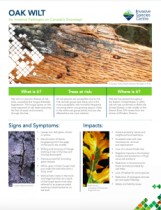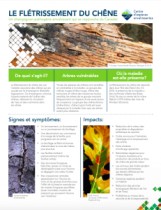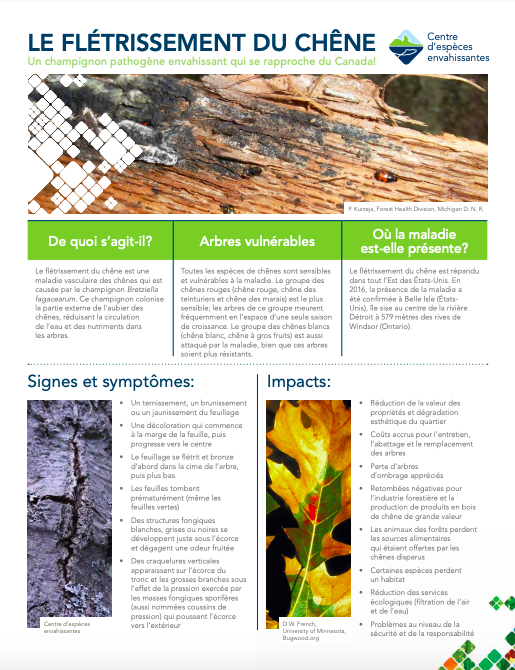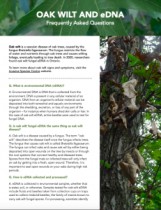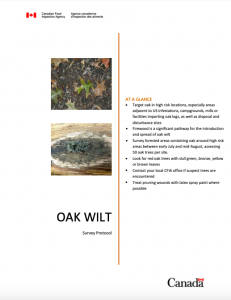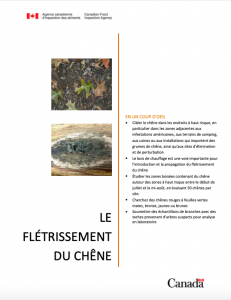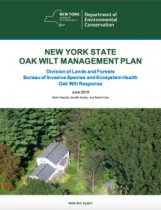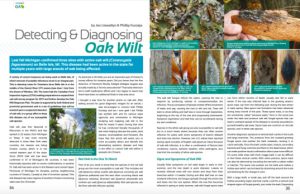In June 2023, the first confirmed detection of oak wilt was found in Canada.
Oak wilt has been found in the following locations:
- City of Niagara Falls, Ontario (first confirmed detection of oak wilt in Canada);
- Township of Springwater, Ontario;
- Town of Niagara-on-the-Lake, Ontario.
To help prevent the spread, movement restrictions are in place on affected properties. The Canadian Food Inspection Agency (CFIA) is working with other federal, provincial and municipal governments to survey the area and determine next steps.
Report any potentially infected trees to
OakWiltReportingOntario-Fletrissementduchene@inspection.gc.ca.
Oak Wilt (Bretziella fagacearum)
French common name: Flétrissement du chêne
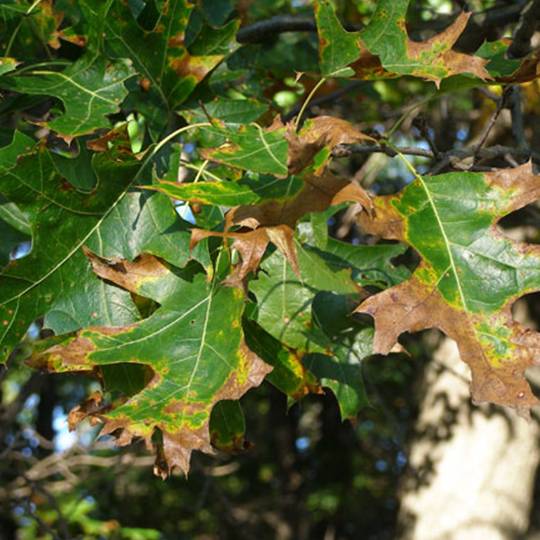
Oak wilt leaves impacted by oak wilt.
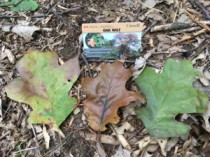
Side by side comparison of healthy vs. oak wilt-damaged leaves.
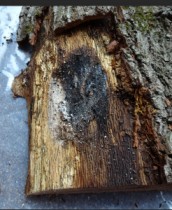
Bark infected by oak wilt.
Order: Microascales
Did you know? Oak wilt kills thousands of oak trees each year in urban and natural forests.
Oak wilt is a vascular disease of oak trees, caused by the fungus Bretziella fagacearum*. The fungus grows on the outer sapwood of oak trees, restricting the flow of water and nutrients through the tree. Some oak species are more vulnerable than others and can die within a year of infection. In some severe cases, red oaks can mortality can occur within 2-6 weeks following infection.
Oak wilt has been confirmed in 24 U.S. states, some of which border Ontario. The disease was confirmed in Niagara Falls, Ontario in May 2023, making it the first known case of oak wilt in Canada. The origin of the fungus is unknown, but it is believed to have been present in North America since the early 1900’s.
*Previously classified as Ceratocystis fagacearum.
The Invasive Species Centre is holding virtual and in-person events this summer, including a virtual Oak Wilt Question and Answer Expert Panel Webinar to discuss frequently asked questions about the new invader.
Watch the Oak Wilt Question and Answer Expert Panel Webinar here.
Sign up for our email list to be the first to know about upcoming events.
The Invasive Species Centre’s Oak Wilt Wire is a bi-annual digital newsletter focused solely on oak wilt news. This newsletter will highlight oak wilt in the news, interesting new research, new developments in prevention and management, community oak wilt champions, and updates from oak wilt experts. Tips and trivia are also included to keep you sharp on oak wilt knowledge! If you consider yourself an oak wilt champion in your community and would like your work to be highlighted, please contact us and share your stories!
Want to learn more about oak wilt? Check out the ISC’s Invasive Species Training Program and enroll in Oak Wilt Training. This course provides participants with the knowledge and tools to identify, prevent, report, and manage oak wilt in their community and workplace.
Oak wilt was named after the characteristic leave wilting observed on infected trees. Bretziella fagacearum spreads through the vascular system of oaks, restricting the movement of water and nutrients up towards the leaves. The leaves of infected oaks can start to wilt and drop prematurely, eventually resulting in complete defoliation.
The leaves will begin turning brown at the outer edges first and will move in towards the middle margin. Leaf discolouration and wilting typically starts at the top of the canopy and moves down over time.
The fungus Bretziella fagacearum develops sporulating mats between the sapwood and bark of dead red oak trees. These mats, called “pressure pads” by technicians, can vary in size, are generally produced in late fall or early spring, and remain visible for two or more weeks. They are usually observed on the trunk or large branches of the tree (CFIA, 2012).
Oak wilt is caused by the fungus Bretziella fagacearum, which grows on the outer sapwood of oak trees. The main period of infection occurs during the spring. In the case of red oak, fungal spores can be transported through all parts of the tree as the tree nears death. In white oaks, however, the distribution of fungal spores is restricted to only the xylem of the current year’s growth (CFIA, 2012).
Sporulating mats that develop on the bark of dead red oak trees attract sap beetles to feed. The sticky spores from these mats adhere to the insects’ bodies, after which they are carried to healthy trees and deposited in tree wounds.
The fungus can spread naturally in two ways: above-ground or below-ground.
Above-ground: When a diseased red oak dies, the fungus produces sporulating mats on the dead tree (these mats are not produced on living trees or white oaks). Nitidulid beetles, or bark beetles, then feed on these fungal mats and pick up spores on their bodies which they then carry from the infected tree to wounds on healthy trees.
Below-ground: The fungus can travel from infected trees to healthy trees through interconnected roots that have grafted together by trees of the same species. The Bretziella fagacearum fungus tends to survive on the above-ground parts of the infected tree for up to one year after the tree has died. However, the fungus can survive considerably longer than this on the below-ground roots of the tree (CFIA, 2012). In addition, the fungus can be spread artificially over longer distances by humans through the transport of infected wood products or nursery stock.
All species of oak trees (Quercus sp.) have been found to be susceptible to oak wilt, with species of red oak being the most seriously affected (CFIA, 2012).
In white oaks, oak wilt infections may appear to be confined to select branches or sections of canopy. Unlike trees in the red oak family, white oaks have the capacity to localize infections through cellular projections called tyloses. The result of these cellular differences is that infections can spread through red oaks more rapidly, ultimately resulting in seeing red oak mortality more quickly and more frequently when compared to white oaks.
Signs and symptoms vary depending on the species of oak that is infected. Red oak species are most susceptible to oak wilt and can die quickly, often within a year of infection. White oak species can often survive infection for several years with few symptoms and slow tree decline.
Signs:
- White, grey, or black fungal mats, also referred to as “pressure pads”, just under the bark that sometimes emit a fruity smell
- Dark rings (vascular streaking) can be seen in the cross-sections of infected branches
Symptoms:
- Wilting and bronzing of the foliage, starting from the top of the tree and moving down
- Discolouration of the leaves, beginning at the leaf margin and progressing to the midrib
- Premature leaf fall
- Vertical bark cracks in the trunk and large branches from the fungal spore mat exerting outward pressure on the bark
Fungal growth on the sapwood of an infected oak. |
|
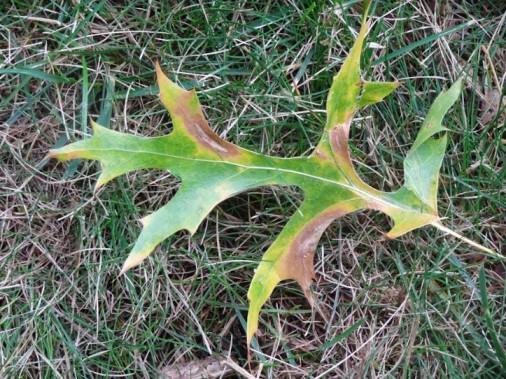
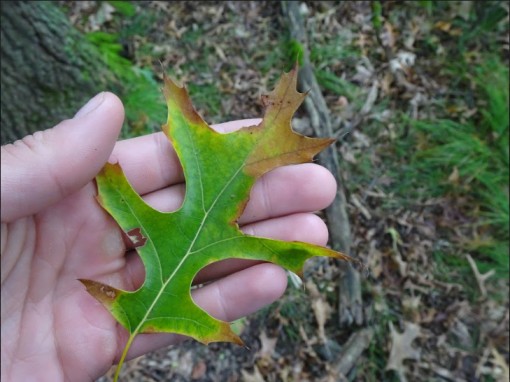
Bretziella fagacearum is believed to have been present in North America since the early 1900’s and has since been confirmed in 24 U.S. states, including Michigan, Ohio, Pennsylvania, and New York. In 2016, it was found on Belle Isle, MI, less than 1 km away from the shores of Windsor, Ontario.
On June 12th of 2023, oak wilt was confirmed present on a residential property in Niagara Falls, Ontario, marking the first instance of the invasive pathogen in Canada. The detection was reported by an arborist on May 23rd who had been contacted by the property owners to provide a quote for the removal of three dead oak trees. The arborist recognized the signs and symptoms of oak wilt and contacted the Ontario Federation of Anglers and Hunters, which then forwarded the information to the Canadian Food Inspection Agency (CFIA). The CFIA followed up on site and collected samples from three affected trees, which were confirmed positive for oak wilt after lab analysis was conducted.
Following this first detection, a dedicated email address was established for reporting potential cases of oak wilt to the CFIA. CFIA, ISC and other partners launched outreach campaigns, webinars, and other initiatives to increase awareness among the public. A second detection of oak wilt occurred on June 22nd in the Township of Springwater, Ontario. A report of a single infected tree was submitted to a local CFIA office in Barrie based on symptomatic leaves. The tree was confirmed positive for oak wilt by the CFIA. Surveying of surrounding areas was conducted with no additional infected trees discovered.
On July 10th, the CFIA confirmed the third official detection of oak wilt in Canada within the Town of Niagara-on-the-Lake. Subsequently, on July 12th, Niagara College confirmed that this detection had occurred on their Daniel J. Patterson Campus. In mid-September of 2023, the CFIA directed the removal of infected trees to occur after November 1st in a CFIA-approved manner.
In response to these detections, the CFIA has enforced movement restrictions and is conducting surveys on affected properties. Should further detections occur, a Notice to Dispose as well as a Notice of Prohibition of Movement may be issued to affected property owners. The CFIA in collaboration with federal, provincial, and municipal governments will continue to survey affected areas and determine next steps. In Canada, there have not been any new detections of oak wilt outside of Ontario. Tree removals have taken place in Springwater, Niagara-on-the-Lake, and Niagara Falls. Trees infected with oak wilt, suspected of having oak wilt and/or in close proximity to oak trees known to be infected were removed. Additional tree removal will take place in Niagara Falls before March 31, 2024. Tree removals, including stumping, was carried out by local contractors, and overseen by city forestry staff and the CFIA to ensure that appropriate sanitation procedures of tools and equipment were followed. Removed trees were transported off-site and buried with CFIA oversight. Monitoring efforts are ongoing and include a radius of 1.6 km around ground zero.
In Niagara Falls, tree removal is expected to be completed before March 31, 2024, however the exact date is not yet determined. CFIA will continue survey activities in affected areas for five years, at which time if no additional detections occur, oak wilt will be considered officially eradicated.
There are a few different resources that may be helpful when learning more about oak wilt distribution:
- EDDMapS provides species distribution maps of invasive species that have been reported in North America by members of the public.
- The Michigan Department of Natural Resources has developed a “Look for Oak Wilt” mapping tool that can be used to track oak wilt and create new reports. Submissions of reports will be confirmed by Michigan DNR staff.
- The USDA Forest Service Eastern Region has also developed a story map to outline the status of oak wilt in the northeastern and midwestern states. These maps can be used to learn about the pathogen and stay up to date on its distribution.
- The Alien Forest Pest Explorer database provides a map of oak wilt reports (and other major pests) throughout the United States.
Regulation
The following Canadian Food Inspection Agency (CFIA) plant protection policies relate to oak wilt caused by the fungus Bretziella fagacearum:
- D-08-04 – Plant Protection Import Requirements for Plants and Plant Parts for Planting: Preventing the Entry and Spread of Regulated Plant Pests Associated with the Plants for Planting Pathway
- D-01-12 – Phytosanitary Requirements for the Importation and Domestic Movement of Firewood
- D-99-03 – Phytosanitary Measures to Prevent the Entry of Oak Wilt Disease (Ceratocystis fagacearum (Bretz) Hunt) from the Continental United States
- D-98-08 – Entry Requirements for Wood Packaging Materials Produced in All Areas Other Than the Continental United States.
Oak wilt could have devastating impacts to oak populations in Canada. As a result, the Canadian Food Inspection Agency currently regulates the importation of oak materials in an attempt to prevent the spread of oak wilt in Canada (OFAH/OMNR Invading Species Awareness Program, 2012).
When compared to the impacts of many invasive insects and diseases such as emerald ash borer, Dutch elm disease, etc., oak wilt has a higher management success rate due to the slow spread of the disease and the fact that a wound must be made at the right time of year for an infection to occur at all. The state of Michigan has been managing oak wilt since the 1950s and still has stable oak populations throughout its urban and natural forests. Different areas will have different risk levels of potential oak wilt spread and damage, ranging from high to low risk.
Economic impacts
Infected red oaks usually die within one year of infection (often within the first 2-6 weeks). The loss of commercially valuable red oak trees will have negative impacts on local forest-based communities and would reduce wood and timber supply for the forest industry.
One study estimated the cost of oak tree removal and replacement in city streets to be as high as $420 million in eastern Canada alone (Pedlar et al., 2020). Oak trees also commonly occur in urban areas on homeowners’ properties. Those that are adjacent to homes can help to reduce energy costs by shading houses in the summer and protecting them from wind in the winter. There are over 180 million oak trees in eastern Canada that provide $41 million worth of ecosystem services per year (Pedlar et al., 2020). These benefits would be quickly lost after infected tree death and removal.
Ecological impacts
The introduction of oak wilt could reduce the number of oak trees, especially red oak, which currently grow in urban and natural areas. The loss of these trees could lead to a decline in biodiversity, a reduction in habitat and food for other wildlife, and a loss of the environmental services previously supplied by these trees.
Oak trees also play an important ecological role in stabilizing slopes, limiting soil erosion, and reducing air pollution (OFAH/OMNR Invading Species Awareness Program, 2012). Oaks are important mast-producing species that produce acorns for other wildlife species. The loss of oak trees could impact the survival of forest-dwelling animals by reducing their food supply.
Social impacts
There have been large social impacts observed in affected regions of the U.S. In urban areas, the loss of oak trees has lowered property values and has reduced available ecological services (such as filtering of air and water).
Oak trees are culturally valuable and are often a staple in parks, backyards, and woodlots. For example, oak was made the official tree of Toronto, Ontario in May 2023. In Toronto, oak trees are estimated to make up about 2% of the cities canopy cover and are found in many popular destinations, including High Park and Queens Park. Dead and dying oak trees infected with oak wilt would not only be visually unappealing but would also be hazardous for visitors and residents.
Oaks are also considered medicine trees in several Indigenous communities, representing strength and protection.
Preventing the spread of oak wilt is the best way to protect oak trees. There are a few different strategies that aid in the prevention of oak wilt:
- Don’t move firewood, as it may contain live fungal spores
- Don’t prune or damage oak trees between April and October, as this is the most vulnerable time for overland spore spread. If pruning must occur, paint a thin layer of wound paint or shellac on thewound immediately. Wounds caused by storms or other events should also be painted immediately
- Learn how to identify the signs of oak wilt
- Communicate with others about the potential threat
- Report summer leaf fall and sudden die off of oaks. Check out the ‘Detect’ section below for tips on where and how to report.
Early detection allows for rapid response and control of the disease to protect Canadian oaks. Landowners should contact their local forestry agency to assess and test their area.
High risk areas of Ontario and Quebec are under surveillance. The map below indicates areas that were surveyed in Ontario and Quebec, green arrows indicating that oak wilt was not detected in these areas.
There are several signs and symptoms that may indicate an infection, however, laboratory confirmation using one of the following methods is required for a definitive diagnosis (Llewellyn & Kurzeja, 2017):
- Culture Wood Tissue on Selective Agar Media
- Polymerase Chain Reaction (PCR)
When sampling, wood samples are collected from main stems or branches, with a diameter greater than 6 cm, while the wood is still moist. Culturing takes 8-10 days of incubation while PCR takes 4 business days. PCR is the more accurate and rapid of the two laboratory methods but involves special tools and materials that not all laboratories will have.
If you have found a suspect oak wilt, download and complete the following sampling protocols:
- Survey Guidelines for Oak Wilt (Ceratocystis fagacearum ) – ENGLISH
- Lignes directrices pour les enquêtes sur le flétrissement du chêne(Ceratocystis fagacearum)- FRANÇAIS
Suspected sightings should be immediately reported to the CFIA OakWiltReportingOntario-Fletrissementduchene@inspection.gc.ca
CFIA will dispatch a technician to aid in your survey and take the sample directly.
There are several methods currently being used to control the active spread of oak wilt in the U.S.:
Removal of infected trees
Infected or dead oaks that have been diagnosed should be removed and disposed of to prevent spore mats from forming. This is done by:
- Debarking, chipping or splitting, and drying the wood;
- Wrapping cut trees in plastic and burying edges;
- Controlled burning or burying of cut trees (USDA, 2011).
Following removal, stumps should be pulled using a backhoe or bulldozer and then immediately flipped, burned, or buried. This prevents regrowth and breaks possible root grafts (USDA, 2011).
Breaking root connections
The infection can spread between trees through interconnected root systems. Root grafts create an opportunity for spores to spread from infected trees to healthy trees without the need of vectors as with overland spread. Unfortunately, there is no way of knowing which trees have grafted roots, so many are sacrificed using this method of control. There are a few methods used to disrupt root grafts:
- Vibratory plows are often used to break any grafted roots between an area of infection and area without
- Backhoes can be used in the same way and can be more effective in rocky soils (USDA, 2011).
Chemicals
Chemical control is often used in association with and in the absence of large machinery. Trunk injections are performed by trained arborists to prevent the spread of oak wilt. (USDA, 2011). Fungicides can also be applied to unaffected oaks to protect the tree from oak wilt for two years after treatment (USDA, 2011).
Management varies depending on several site and environmental factors. Contact a local arborist for more information on how to treat oak trees in your area. A great place to start looking for a trained professional is the International Society of Arboriculture, which has 5 Canadian Chapters, including Ontario, Quebec, Atlantic, Prairie, and Pacific Chapters.
ISC Resources
Management Sheets
More Resources
Video Resources
Further Reading
The Invasive Species Centre aims to connect stakeholders. The following information below link to resources that have been created by external organizations.
Journal article “Assessing the climate suitability and potential economic impacts of oak wilt in Canada” by Pedlar et al., 2020. Access it here.
Oak Wilt: People and Trees, A Community Approach to Management
(large download – entire contents of a CD created in 2003)
https://www.nrs.fs.fed.us/pubs/1878
Wisconsin Oak Wilt Guide
https://dnr.wi.gov/topic/foresthealth/OakWiltGuide.html
Oak Wilt in Michigan’s Forest Resource
http://msue.anr.msu.edu/resources/oak_wilt_in_michigans_forests
The season for oak wilt is about to begin. A bit of knowledge might prevent a lot of heartache. – Bill Cook
http://msue.anr.msu.edu/news/oak_wilt_disease
Protecting oaks from oak wilt disease starts with restricting times trees are pruned to the cold weather season. – Bob Bricault
http://msue.anr.msu.edu/news/prune_oaks_in_winter_to_avoid_oak_wilt
Proper diagnosis of oak wilt disease may prevent loss of surrounding trees. – Bob Bricault
http://msue.anr.msu.edu/news/oak_wilt_diagnosing_and_preventing

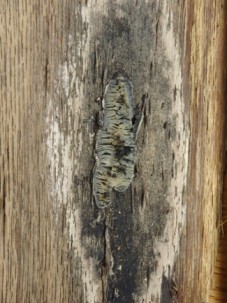
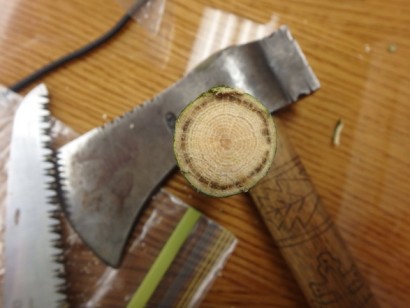 Cross-section of an infected oak with severe vascular streaking.
Cross-section of an infected oak with severe vascular streaking.